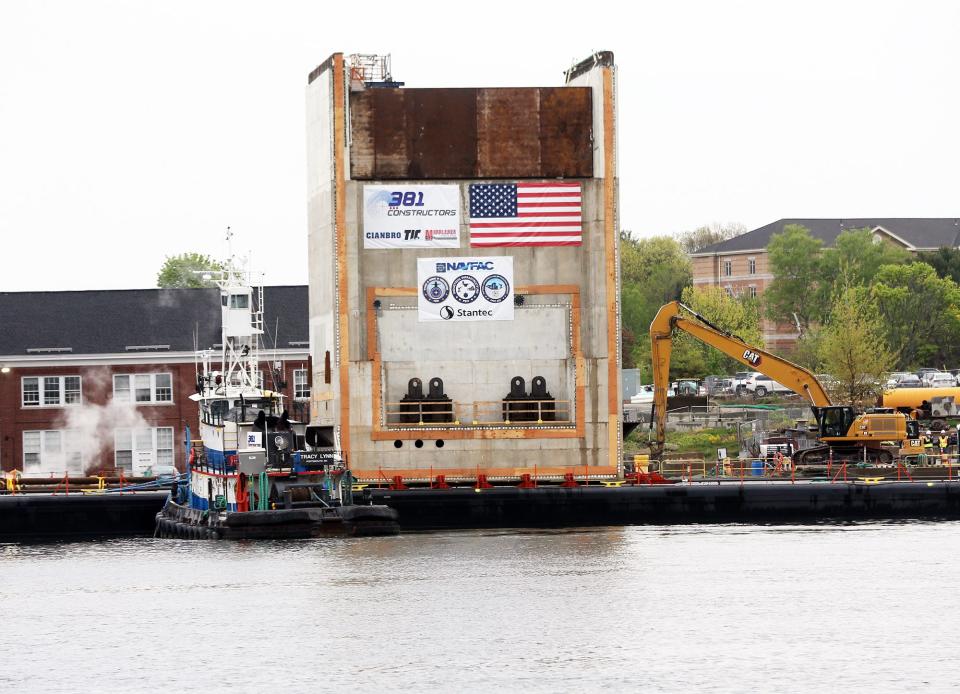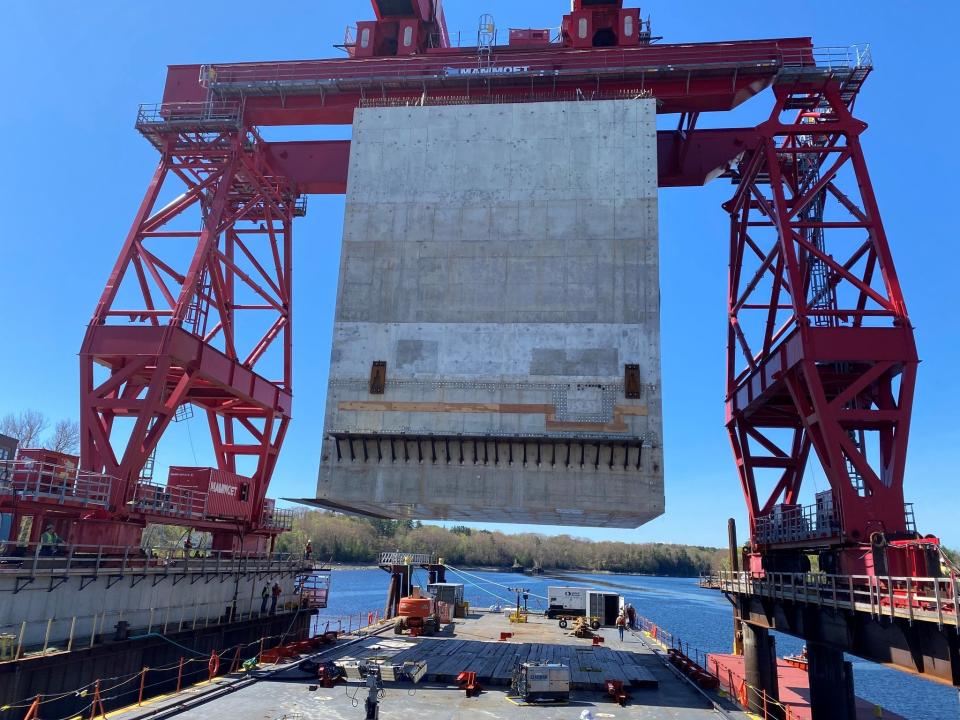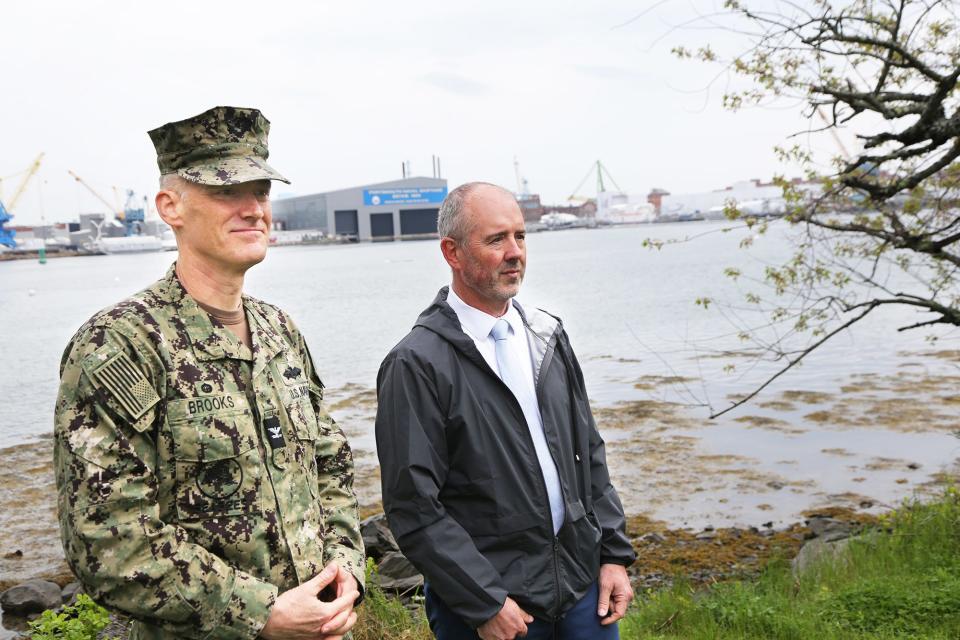What is 3,700-ton arrival at Portsmouth Naval Shipyard? Part of yard's transformation
KITTERY, Maine — A 3,700-ton concrete monolith floated on the Piscataqua River to the Portsmouth Naval Shipyard on Thursday, the first of more than two dozen being delivered to complete the yard's $1.8 billion dry dock expansion project.
The federally funded effort to expand the shipyard’s Dry Dock 1 area is progressing on schedule, now in its third year and projected to be completed on time in 2028. The seven-year project is part of the federal Shipyard Infrastructure Optimization Program to upgrade the nation’s four public shipyards.

At the end of its expansion, the shipyard will be able to hold five Los Angeles- and Virginia-class submarines for repair, maintenance and modernization efforts, an upgrade from its three-submarine capacity in its three dry dock stations. Dry Dock 1 will be able to hold two submarines upon the completion of the expansion.
Billions invested to 'transform' Portsmouth Naval Shipyard
“We’re creating 100-year infrastructure,” said Capt. Chad Brooks, the officer in charge of construction at the shipyard, and a native of nearby Greenland, New Hampshire. “That’s the anticipated service length. Building it correctly to that high level of precision is how we achieve the quality standard for the required service length.”
Twenty-seven concrete monoliths, sent from Cianbro Corporation's modular manufacturing facility in Brewer, Maine, and varying from four to six stories in height, will be floated on the fast-paced river to the shipyard every few weeks over the next year. Each will be a piece in the puzzle to expanding Dry Dock 1.

The first monolith was delivered Thursday with an American flag draped across it. The structure is expected to be moved into the dry dock basin in early June, lifted with the help of a 110-foot-tall steel red lifting device that was transported on the river to the 224-year-old shipyard in April.

Russell Gagner, director of the Shipyard Infrastructure Optimization Program’s execution at Portsmouth Naval Shipyard, stated $2 million worth of work is put in daily for the Dry Dock 1 enlargement project.
“This is really the one time going into the future that we are going to be able to transform the shipyard, (turning) a shipyard that was really built and developed to build submarines into a shipyard that's ready for modernizing submarines,” he said Thursday. “This will turn this into the best fast attack submarine facility in the world. This is really the cornerstone project for that opportunity.”
The Dry Dock 1 project was celebrated by Secretary of the Navy Carlos Del Toro and members of Maine and New Hampshire’s congressional delegations in an August 2021 ceremony at the Portsmouth Naval Shipyard. At the time, $1.7 billion was allocated for the project, a figure that increased over time.
Shipyard economic impact in Seacoast: Towns with most workers, payroll listed here
The Portsmouth Naval Shipyard project was at that point the Navy’s largest-ever military construction project.
“There's now a similar project awarded in Pearl Harbor for a dry dock. There’s another one there, as well,” Brooks said. “But we monitor the financial health of the project very carefully. At this time, we're operating within our budget and the scheduling requirements so that we can deliver the capability.”
“The Shipyard Infrastructure Optimization Program is a holistic recapitalization of the Navy’s four public shipyards through a combination of new and existing facilities,” Gagner added. “SIOP is a holistic plan that integrates investments in facilities, utilities, and industrial plant equipment to meet nuclear fleet maintenance requirements. The program delivers a reduction in submarine availability duration and improves efficiency by expanding shipyard capacity, optimizing configuration, and creating resilient infrastructure-enabling (the shipyard) to meet the Navy’s requirements for decades to come.”
Shipyard once faced closure, now is expanding

Growing up locally, Brooks would visit Prescott Park each year and look out at the Portsmouth Naval Shipyard, gazing at his future place of employment. Seacoast and southern Maine residents worried the Navy could close the shipyard, similar to the closure of Pease Air Force Base in Portsmouth in 1991.
The yard was famously saved from closure in 2005 and times have changed. Turn your eyes now to the Portsmouth Naval Shipyard across the river and you’ll view a number of cranes and lift machinery amid ongoing construction of the dry dock, while behind-the-scenes maintenance on existing facilities and equipment takes place on Seavey Island.

“To be back now, after more than 30 years away, to see the Navy making a generational investment in the shipyard is very gratifying,” Brooks said. “The shipyard is here to stay. It is absolutely a cornerstone of nuclear attack submarine maintenance. From a Navy and national perspective, that is a critically important mission for our national defense. To be a part of that with this team is extremely gratifying.”
The historic Dry Dock 1 was originally constructed during World War II. The first three submarines were launched from the dry dock on Jan. 27, 1944.
This article originally appeared on Portsmouth Herald: 3,700-ton monolith floats to Portsmouth Naval Shipyard: What is it?

